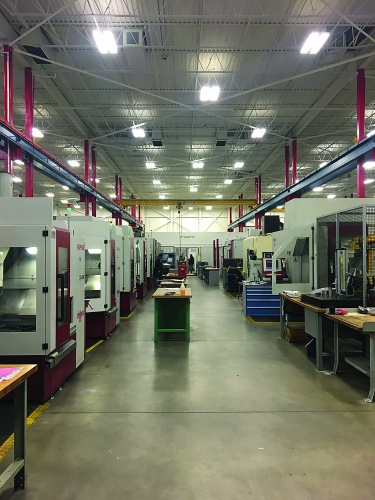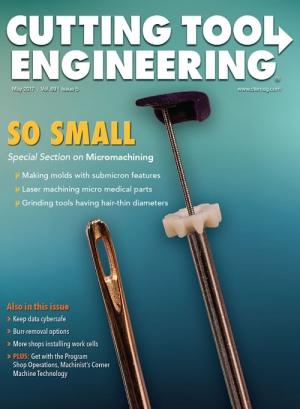Craftsman Jasper Röders set up shop during the early 1800s to make pewter tableware for his neighbors in Soltau, Germany. Six generations later, his descendants still produce pewter but have expanded into blow molds and CNC machine tools.
G.A. Röders GmbH & Co. KG’s RXP line of high-speed milling and grinding machines are available in North America from Roeders of America Inc., Valley Cottage, N.Y.
Roeders president, Victor Pfister, said the 3-, 4- and 5-axis machining centers can impart optical-quality finishes and achieve extreme accuracy. “The company has extensive experience in moldmaking and was unable to find machine tools that would do what we needed,” he said. “So around 25 years ago, we started building our own equipment. We use only linear-drive and direct-drive torque rotary motors, so there are no issues with wear components or backlash.”

Roeders machines offer spindle speeds up to 90,000 rpm and are capable of imparting surface finishes finer than 0.01μm Ra. This image shows the shop floor at injection mold manufacturer StackTeck, Brampton, Ontario, which has 11 Roeders machines and another on order. Image courtesy of Roeders of America.
The spindle and other key machine components are temperature-controlled, he added, and some machines are available with 60,000-rpm and 90,000-rpm air-bearing spindles, which are suited for optics machining. These spindles have about a tenth the runout of hybrid ceramic-bearing spindles, according to Pfister, but are limited to light-duty work, so the company also offers many other spindle options for hard milling. Some machines have dual spindles to rough and finish injection molds and optics in the same setup.
“For metals much harder than the low-60s HRC, we have a jig grinding option,” he said. “We use our own proprietary control and 32-kHz drive technology, with 10,000-block look-ahead and 0.1-millisecond block-processing time.”
Pfister said the goal is to produce injection molds that don’t require polishing. Also, optical surfaces benefit when they are machined without being touched afterwards.” In either case, the ability to machine surfaces to within ±0.00004" (1.02µm) and finishes to finer than 0.01μm Ra is a high standard against which Pfister said competing machine tools must measure themselves. “We’re very specialized,” he said, noting the company doesn’t offer EDMs or commodity machines. “In terms of building machines, we’re focused exclusively on high-speed milling. That is all we do, and it gives us a tremendous technological advantage.”
Related Glossary Terms
- backlash
backlash
Reaction in dynamic motion systems where potential energy that was created while the object was in motion is released when the object stops. Release of this potential energy or inertia causes the device to quickly snap backward relative to the last direction of motion. Backlash can cause a system’s final resting position to be different from what was intended and from where the control system intended to stop the device.
- centers
centers
Cone-shaped pins that support a workpiece by one or two ends during machining. The centers fit into holes drilled in the workpiece ends. Centers that turn with the workpiece are called “live” centers; those that do not are called “dead” centers.
- computer numerical control ( CNC)
computer numerical control ( CNC)
Microprocessor-based controller dedicated to a machine tool that permits the creation or modification of parts. Programmed numerical control activates the machine’s servos and spindle drives and controls the various machining operations. See DNC, direct numerical control; NC, numerical control.
- gang cutting ( milling)
gang cutting ( milling)
Machining with several cutters mounted on a single arbor, generally for simultaneous cutting.
- grinding
grinding
Machining operation in which material is removed from the workpiece by a powered abrasive wheel, stone, belt, paste, sheet, compound, slurry, etc. Takes various forms: surface grinding (creates flat and/or squared surfaces); cylindrical grinding (for external cylindrical and tapered shapes, fillets, undercuts, etc.); centerless grinding; chamfering; thread and form grinding; tool and cutter grinding; offhand grinding; lapping and polishing (grinding with extremely fine grits to create ultrasmooth surfaces); honing; and disc grinding.
- jig
jig
Tooling usually considered to be a stationary apparatus. A jig assists in the assembly or manufacture of a part or device. It holds the workpiece while guiding the cutting tool with a bushing. A jig used in subassembly or final assembly might provide assembly aids such as alignments and adjustments. See fixture.
- look-ahead
look-ahead
CNC feature that evaluates many data blocks ahead of the cutting tool’s location to adjust the machining parameters to prevent gouges. This occurs when the feed rate is too high to stop the cutting tool within the required distance, resulting in an overshoot of the tool’s projected path. Ideally, look-ahead should be dynamic, varying the distance and number of program blocks based on the part profile and the desired feed rate.
- milling
milling
Machining operation in which metal or other material is removed by applying power to a rotating cutter. In vertical milling, the cutting tool is mounted vertically on the spindle. In horizontal milling, the cutting tool is mounted horizontally, either directly on the spindle or on an arbor. Horizontal milling is further broken down into conventional milling, where the cutter rotates opposite the direction of feed, or “up” into the workpiece; and climb milling, where the cutter rotates in the direction of feed, or “down” into the workpiece. Milling operations include plane or surface milling, endmilling, facemilling, angle milling, form milling and profiling.
- polishing
polishing
Abrasive process that improves surface finish and blends contours. Abrasive particles attached to a flexible backing abrade the workpiece.


